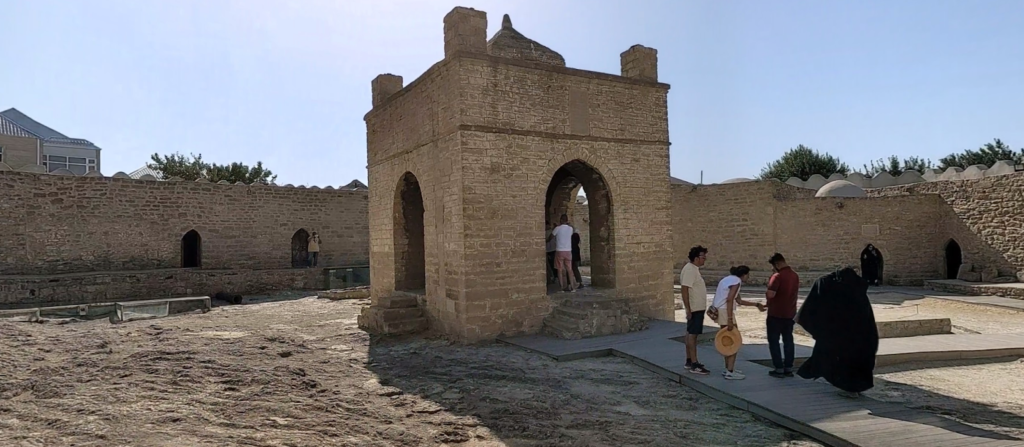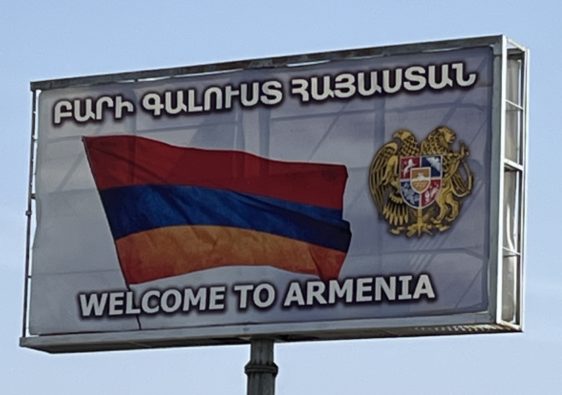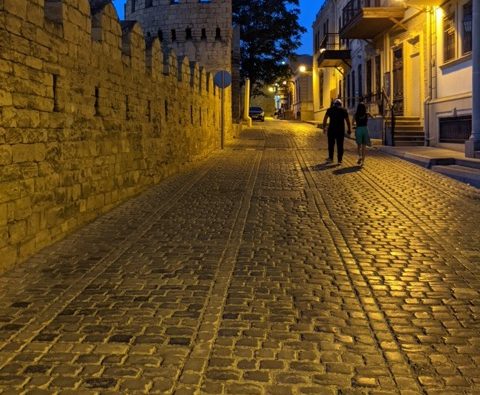As fascinating as we found Baku with contrasting quaint streets and shiny modern architecture, we were excited to take a city break to the outskirts of the capital. Because Tauni & I made a pact not to drive on this trip (Georgia, Azerbaijan, Armenia roads–it’s a jungle out there), we once again signed up for an excursion we found via Tripadvisor. Historically (until this trip at least) we have avoided organized tours–we tend to wander and don’t like to be tied to a group; BUT on this Caucasus odyssey we really came to appreciate the opportunity to connect with locals on our small group tours. We did not go wrong on today’s day trip to the environs of Baku.
Our seasoned, charming, and not-the-least-bit-politically-correct guide picked us up on time at our hotel and we spent a few minutes rounding up a few others in our Mercedes mini-bus. There were about 16 people in our group, from all corners of the planet. We headed south of the city for maybe 20 minutes to the Gobustan Mud Volcanoes, which you access literally right off the road. It is a vast and windy desert-like area with dark grey mounds of various sizes. If the sun were not blazing, you would think you were on the lunar surface. On top of these mounds are bubbling pools of, well, mud. There is no guard or supervision (apart from our guide) so you can scurry up the mounds as you wish and check out the mud, it is not hot. It was fun and we stayed under a ½ hour, so not too long.


Our next stop was one I was really anticipating, just up the road to Gobustan National Park. Though I am from the US, I have never visited Arizona or New Mexico, but this dusty landscape matched my perception of what they must look like. It was hot as anything (it was August), and with a warning to stay on the marked path, our guide led us out along the path into the gaps between the various short cliffs.
We were surrounded by prehistoric petroglyphs–rock-writings from some 40,000 years ago. Behind every curve, corner and cave entrance was yet another drawing of humans or animals. It was a humbling reminder of really just how small we are in the expansive chronicles of human history, and while not huge, it is not to be missed. We also had the good fortune of happening upon an archeological project occurring in one of the caves. Very cool to witness that in action.




Our third stop was a roadside cafeteria back on the way to Baku. Cheap eats, big (if not memorable) selection, I think I had some rice & veggies. Then back on the road for the Ateshgah Fire Temple, also on the outskirts of Baku, this time northeast of the city. We passed postage stamp plots of land with small oil rigs. Of course! Azerbaijan is a leading producer of oil, which has funded much of Baku’s modern architecture and shiny airport. Tauni, who lived all over the US, was incredulous that I (Michele) had just never seen an oil rig in person.

Back to the fire temple–a walled, five-sided courtyard surrounded by small rooms where priests/monks of different faiths stayed: Hindus, Persians, Sikh and Zoroastrian. In the center of this courtyard is a small ‘temple’ with a perpetual flame (which is now powered by a natural gas line). There are symbols and writings on the walls reflecting the diverse linguistic history, as well as the range of faiths represented by adherents and pilgrims over the centuries.



The final stop on our tour was to the marvelously conceived Heydar Aliev Center. It was a simple, brief photo and exploration stop. Tauni and I had actually visited it the day prior and enjoyed the incredible woven rugs, as well as the Baku history exhibits. Worth the price of admission and besides the fascinating exhibits, the stunning architecture inside and out make this a very instagrammable ‘must do’ for your photos.



